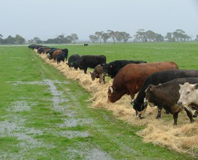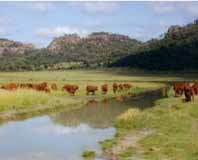Read the latest information on
Foot-and-mouth disease
 With Australia’s eastern seaboard again affected by rainy weather, Australia’s livestock producers are urged to be on the lookout for the extra risks to animal health that wet weather usually brings.
With Australia’s eastern seaboard again affected by rainy weather, Australia’s livestock producers are urged to be on the lookout for the extra risks to animal health that wet weather usually brings.
Water flows often bring with them weed seeds. Some weeds can seriously affect the health and welfare of livestock and others will take over and reduce the nutritional value of grazing land for your stock. Landholders should be especially mindful of weeds arriving from upstream districts in floodwaters, including rarely seen toxic plant seeds that result in new infestations. If you notice any unusual weeds or behavioural changes in livestock, seek advice urgently.
Weed seeds can be carried on or inside animals, to be deposited later elsewhere, and establish in grazing areas. It is important to maintain inspection controls on all livestock that have grazed on recently flooded pastures. If they are rejoining your main flock or herd, isolate them for about ten days to ensure they don’t drop weed seeds into regular grazing lands. Inspect both the animals and their faeces to help prevent harmful weeds establishing on your property.
Want to find out more? Visit our Ferals and weeds page.
In wet and humid conditions it especially important to keep feed in a clean, dry storage area and to keep stores covered to prevent feed from becoming wet and mouldy. If water-logged conditions mean you have to buy in additional feed, always make sure it is fit for purpose by insisting on a Commodity Vendor Declaration. Precautions also need to be taken against feeding spoiled hay when providing supplements for hungry stock to avoid scouring outbreaks. Dispose of old, mouldy or contaminated feed safely, keeping it away from livestock and securing it from pests.
Click here for more tips on keeping feed and water safe for livestock.
Footrot thrives in warm wet weather. It takes only one affected sheep to infect the entire flock and, once established, virulent footrot is very expensive to control and eradicate – especially since there is currently no available vaccine on the Australian market.
It is advisable to check lame sheep and investigate immediately if you suspect the disease may be present. Early detection is critical, because it can prevent lameness and spread of virulent footrot within the flock as well as to other properties. Like many other sheep diseases, virulent footrot most often arrives ‘on the back of a truck.’ Place any new sheep into quarantine, inspect them closely on arrival and always purchase with a fully completed National Sheep Health Statement. If the animals have come from an area where footrot is known to be prevalent, treat them upon entry to the property before placing them into quarantine.
The risk of facial eczema in cattle is greatest in late summer and autumn when periods of rain or high humidity occur in combination with high night time minimum temperatures.
Facial eczema is caused by toxic levels of a fungus which lives mainly on ryegrass, damages the liver and, in some cows, causes skin lesions. The greatest cost of the disease to dairy farmers is from the 80% of cows which have liver damage but no skin lesions. These cows will have lower milk production and fertility.
Wet weather often brings more frequent tick and worm infestations, which are responsible for deadly diseases such as tick fever, bovine anaemia and bovine ephemeral fever (three day sickness). It is a good idea to inspect livestock regularly in current conditions and to check with your local vet for available vaccines and drenches. If you see any unusual signs in your animals, please call the Emergency Animal Disease Hotline on 1800 084 881.
 Arboviruses
ArbovirusesMosquitoes are known to breed quickly in hot, wet conditions and horse owners are urged to remain highly vigilant. Ensure that water collected in buckets and other receptacles is properly drained and not left as an extra breeding ground for mosquitoes.
Owners should try to prevent their animals from being bitten by insects through simple husbandry practices including rugging, fly masks and using registered insect repellents. Ensuring that horses are kept in good condition will help build a strong immune system and minimise the risk of infection with arboviruses. For more information on preventing disease in your horses download the Horse Venue Biosecurity Workbook.
For more biosecurity tools and tips, download the biosecurity plan or manual relevant to your livestock industry.